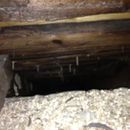Insulating the attic of a 1850s Cape
I am fixing up an 1850s cape in central Vermont. The attic currently has about a dusting to an inch of vermiculite in between the joists. The walls have been blown in but apparently only to the level of the bottom of the upstairs windows. I would like to blow insulation from the attic down the eaves and into to top of the walls so they are insulated full height. I would also like to insulate the attic floor with blown in cellulose to somewhere in the R-48 to R-60 range. My problem is with the eaves and knee wall slanted ceilings in the second story.
The house has no soffit vents and seems to have got along just fine without them for the last 150 years. There are 4 small vents, 2 on either end of the house as seen in the pictures. I’d like to be able to just blow insulation down the eaves fill the wall cavity and then just keep filling till full then do the floor but this goes against most conventional wisdom on airflow, but most of this is based newer construction methods and on having soffit vents…
The attic space is minimal about 32’x14, and maybe 7 feet at the peak. The roof is trussed with 2×4 construction and with nails coming down from the roof and very little space to work in Im not sure how I would get some sort of air space baffle in there at all. Any tips ideas? Oh its a brand new standing seam metal roof at about a 11:12 pitch I’m not too concerned about ice dams even with the old galvanized roof it shed the snow just fine. I have attached some pictures of the attic, the eave space one of the upstairs rooms (mid restoration) and a couple outdoor pictures.
GBA Detail Library
A collection of one thousand construction details organized by climate and house part










Replies
The rest of the pictures...
Jeffrey,
Too bad there is a new roof. The best way to insulate these old Capes is with rigid foam above the roof sheathing, so whoever made the decision to install a new standing-seam roof without installing rigid foam lost a golden opportunity -- an opportunity that won't return for about 70 years, when the roofing finally wears out.
You've got some headaches. Hurdle number one is the vermiculite. You have to assume that it contains asbestos. Stay out of the attic. Don't disturb the vermiculite in any way. You can't do any air sealing or insulation work until you've paid for an asbestos abatement contractor to remove the vermiculite. Bummer.
For information on the various options you have for insulating the sloped ceiling, see How to Build an Insulated Cathedral Ceiling. For information on insulating kneewalls, see Two ways to insulate attic kneewalls.
Isn't it true that not all vermiculite contains asbestos, but just a small portion from a vein in Libby, Montana? You could ship a large food storage bag with a full sample to a testing lab. A "negative" might offer some peace of mind (though complete abatement would, too). Good luck.
John and Jeffrey,
Here are recommendations from the Environmental Protection Agency:
"A mine near Libby, Montana, was the source of over 70 percent of all vermiculite sold in the United States from 1919 to 1990. There was also a deposit of asbestos at that mine, so the vermiculite from Libby was contaminated with asbestos. Vermiculite from Libby was used in the majority of vermiculite insulation in the United States and was often sold under the brand name Zonolite. If you have vermiculite insulation in your home, you should assume this material may be contaminated with asbestos and be aware of steps you can take to protect yourself and your family from exposure to asbestos. ...
"You should assume that vermiculite insulation is from Libby and treat the material as if it contained asbestos by not disturbing it or by using a trained professional if it needs to be removed. Since the Libby mine was estimated to be the source of over 70 percent of all vermiculite sold in the United States from 1919 to 1990 and vermiculite from Libby was contaminated with asbestos, further testing is not necessary to take the appropriate precautions. While you can hire a trained professional to test your attic for asbestos, this may be expensive and, depending on the methods used, might give you erroneous results. ...
"Asbestos causes cancer and other diseases. There is no known safe level of asbestos exposure. Asbestos fibers must be airborne to cause a health risk through inhalation, so the first step is not to disturb the material, which would release more fibers into the air. If you remove or disturb the insulation, it is probable that you may inhale some asbestos fibers - the degree of health risk depends on how much and how often this occurred. ...
"Also, you need to consider if any disturbance of the insulation - possibly by a contractor doing work in you attic - may result in the fibers being deposited into other areas of your house where an exposure might be possible. ...
"If You Have Vermiculite Insulation, YOU SHOULD ASSUME THE VERMICULITE CONTAINS ASBESTOS AND DO NOT DISTURB IT! Any disturbance could potentially release asbestos fibers into the air."
Uh-oh. Thank you, Martin. I will pass this on to a local weatherization agency that does not necessarily treat vermiculite with the same degree of caution.
I'm very glad this Q&A is edited (by you); I'm embarrassed to have committed the very offense I occasionally rail against: partially informed (but well meaning) free web advice.